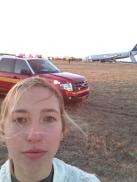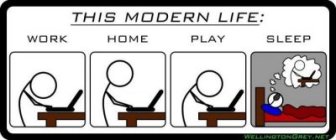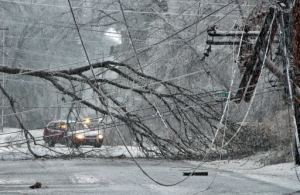I read an article today about a fatal accident that occurred in the Dallas/Fort Worth, TX area yesterday (6/3/2014). The article focused somewhat on the accident itself, but moreso on the reaction of an off-duty responder who noticed bystanders using their phones to capture footage of the accident, rather than assisting. (You can find the aforementioned article here in a new window if you’re interested in its content before reading further.)
The article shares the point of view of Lt. Anthony Williams (the off-duty responder) who attempted to assist in the incident as he pulled on-scene to a burning car where reportedly two people died, burned beyond recognition. He recalled onlookers pointing their phones at the scene in his peripheral vision and called it “the perversion of social media” that they would be more interested in capturing video footage instead of helping the victims. That phrase caught my attention and left me wondering…is that where social media has now led the public in emergency situations?
 Post plane-crash selfie…
Post plane-crash selfie…
Upon further investigation, I found that even being a part of disaster situations isn’t enough to distract from the need to immediately share those experiences on social media. You can search for “selfie after plane crash” or “selfie after stabbed” and there are, in fact, results that turn up by the plenty. Another video seen today made light of a teenager with his dad who saw a semi-truck stuck on some rail road tracks. As a train approached, they began recording the unfolding incident and the video was soon uploaded to YouTube and shared across the web. And the teenager literally stood in the middle of the debris saying, “is this real life??”
So what is encouraging the public to make these choices during disaster situations? I would argue it’s actually a list on influences that should be considerably eye-opening for my fellow emergency management focused friends, especially in their planning and response strategies.
The public isn’t empowered enough to act during disaster.
We spend a lot of our time telling people what they can’t touch, where there can’t go, what can’t do, what they can’t say, or generally protecting whatever “territory” we feel is ours that it’s no wonder community members look a a crisis unfolding and feel helpless to do anything. For the lay community member, what is outside of their daily job function is outside of their “basement” level thinking – the kind of thinking that happens naturally and automatically in response to a stressful situation. (I should note that concept is learned from a 2011 meta-leadership seminar I attended!) For the officer in the story above, jumping into response mode was the obvious choice. For the other bystanders, they’re so often made to feel that the only thing they can and should be allowed to do is wait patiently. Is this all encompassing, of course not. Is it pretty common? Well, the story above is one of many examples.
The public experiences fear, and fear can be paralyzing.
One of my favorite books related to emergency management was Amanda Ripley’s Unthinkable. It’s a great read, not too complicated and very eye opening about the reactions people have to disasters. Plane going down? Everyone shares a laugh. Building burning down? Let’s wait and see what’s REALLY going to happen. Fear paralyzes people, removes their normal thought process and makes excuses against what they’re experiencing to put it in a more digestable format. When you’re afraid, the ability to make rational decisions is quickly diminished, and that lack of recognition and decision making is paralyzing. What do you do when you don’t know what to do? Which leads me to my next thought…
The public has a disconnect with crises.
We’re not empowering them, and without knowledge or training there is fear. And where there is fear and inexperience there is a disconnect from what a crisis really is: a bad situation that can happen to anyone, anytime that is completely dependent on who will step up to handle it. The 24-7 news-like exposure folks have to disaster in our culture so often puts them in a realm of automatic disconnect to the reality of it that when it’s in front of them, it automatically turns into almost a movie-like experience. As long as nothing happens to someone, they will believe that nothing will happen to them. And when it happens to others, it’s a very unfortunate, very impersonal scene that they haven’t been given a role to play in.
The public processes information in a very unprecedented way.
There was a point in my life that if I didn’t know what to do, I’d open my phone and click on Twitter. Or I’d sit down to do a task at my computer and type “Faceb…” before I realized that wasn’t what I wanted to be doing. Am I proud of this fact? No way! “Recovering” is a more accurate description. The point is, social media is a decision A LOT of people make when we’re in the basic, “basement” way of thinking. Nowadays, events haven’t been experienced until they’ve been shared. They’re not processed unless they’re discussed. We use social media to document information, to show we’re the first to know it, to receive empathy, to alert that we’re okay, to share the unbelievable. We use social media to experience that which simply “can’t be happening to me” during the times we “can’t do anything about it” because it isn’t real life until we can go through our notes with those we connect with.
Yes, I realize I’m speaking in absolutes, recognizing this is a thought for a general population and not all-encompassing. But you get the idea. It is a terrible tragedy that anyone should lose their life needlessly in disaster. It’s even worse when there are things that can be done that aren’t done, whether for ones self (evacuating, preparing, sheltering…) or for others.
So what are you going to change about your message and your interactions with your community to humanize the emergency management field, empower your citizens and foster a whole community response to keep these things from happening any more?
Tweet #BiggerThanMyself or mention me @tjlasagna if you have some suggestions. If this is a topic you’d like to see researched further, please also let me know.
-Tanya








